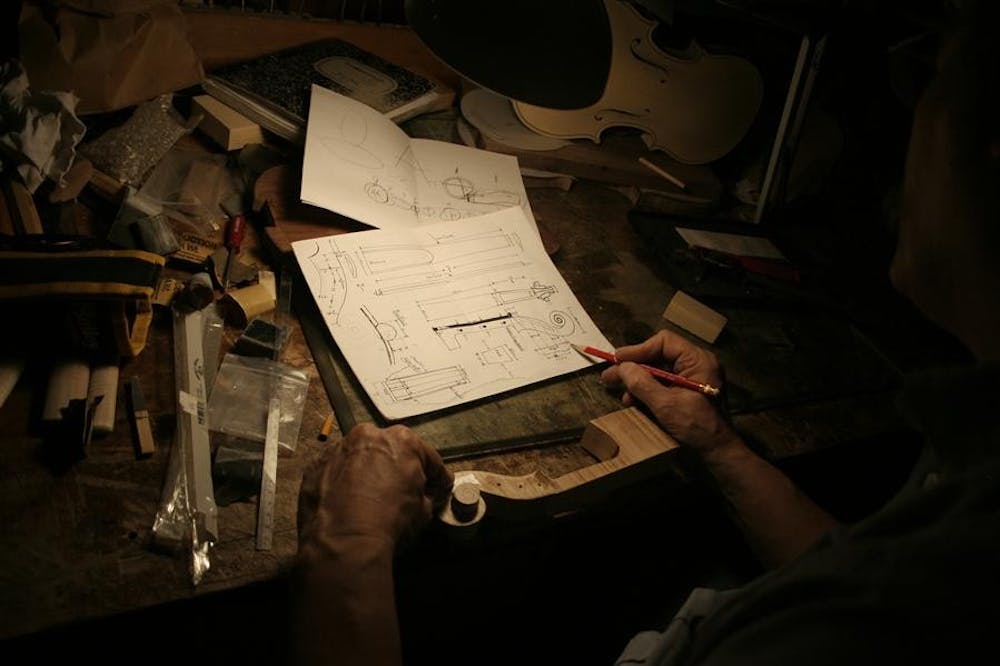Round the circular hallway, stop across from the water fountain, head through the instrument locker room, climb the darkened stairwell and you’ll find it: the string instrument workshop where Tom Sparks builds the tools others in Jacobs School of Music can only play.
Sparks is an expert luthier, a violin maker who creates instruments from blocks of wood, varnish and glue. At the Jacobs School of Music, Sparks is director of string instrument technology.
He teaches a class where learning to build a violin is the complete focus of multiple semesters. He brings his history as an Irish fiddle champion, his years as an artist and the skills he learned here at IU to a new class of luthiers.
In the string instrument lab, he shares his skills with a hodgepodge of first-time learners and experienced woodworkers. As a result, the class attracts graduate students, University faculty and locals with varied experiences. Whatever their skill level, they come here to create.
“It’s the original one-room schoolhouse approach,” Sparks said.
In this case, the schoolhouse is an irregularly shaped, windowless room that resembles a carpenter’s woodshop dumped onto a classical instrument store. Bandsaws and planes stand next to half-carved instruments, some just beginning to take the familiar shape of a violin.
And there’s sawdust everywhere.
It can take up to four semesters for students to complete their violins.
After learning to name and sharpen their tools, the students’ first task is to create a dowel from spruce, to within .02 millimeters of accuracy, Sparks said. Sometimes that project alone will take half the semester.
Students have to match the grains of wood together and focus on extreme precision, skills that will come in handy when they begin to build their instruments.
“It’s pretty amazing what that little task will do for you,” Sparks said.
The Jacobs School offers an associate of science degree in string instrument technology, as well as minor and concentration options for graduate-level students.
Because it requires such precision, students might have to scrap one dowel and begin again. Sparks explained that dowels lay all over the shop, having been discarded by students who didn’t quite meet the requirement.
After the dowel, the real violin making begins. Students take apart an instrument and build the brace, the back piece that creates the form. By the end of the first semester, some have the top and back joined, Sparks said, and maybe a rib cage made to form the side of the violin.
The shop also provides repairs to many of the instruments in the Jacobs collection. The bodies of violins, cellos, violas and basses, some of them in need of repair, hang from the ceiling around the shop.
Andrew Henry is the class’ assistant instructor and a 2007 IU alumnus. He helps with repairs while also assisting in the class. Henry’s background as a viola player drew him to the program, but so did his past in a woodshop.
“My dad is a carpenter, and I grew up around a fair amount of woodworking,” Henry said.
He also builds and sells custom guitars.
He held up a student’s work as an example. The rough shape of the instrument’s front panel had begun to take shape, and the “curves and swoops” Henry described are barely visible. He used a work bench light to find the places where more sanding is necessary.
The next time the student works on this piece, he’ll use a plane — a flat metal tool used to shave the wood down to the desired thickness — to create the familiar contours seen on a finished instrument.
Kit Polen worked on the ribs and brace as Sparks sat quietly in the center of the uneven room.
Polen is a second-year graduate student in the Jacobs School of Music. He began Sparks’ class to fulfill his four-credit outside concentration but says he’ll continue on to complete a minor.
“Or I’ll just stay here until I make a violin. That’ll be exciting.” Polen said.
He held up one of the ribs, a rectangular piece of wood about eight inches long and about an inch across. Polen pointed out a tiny crack in the wood. It can take months to file down this piece of the instrument, and now he’ll have to start this part of the process again.
Polen said he took the class because he wanted to be able to make expensive bass repairs on his own. The work can be painstaking, Polen said, but is completely different and more perceptible than the hours he spends in the practice room with
his bass.
“It’s something that we can’t do downstairs. In the practice room, it’s something intangible,” Polen said.
And at every step, Polen said, Sparks offers a wealth of knowledge “whether you want him to or not.” He keeps the tone light and keeps them sane.
“When you’re dealing with .02 of a millimeter, you have to stay sane,” Polen said.






